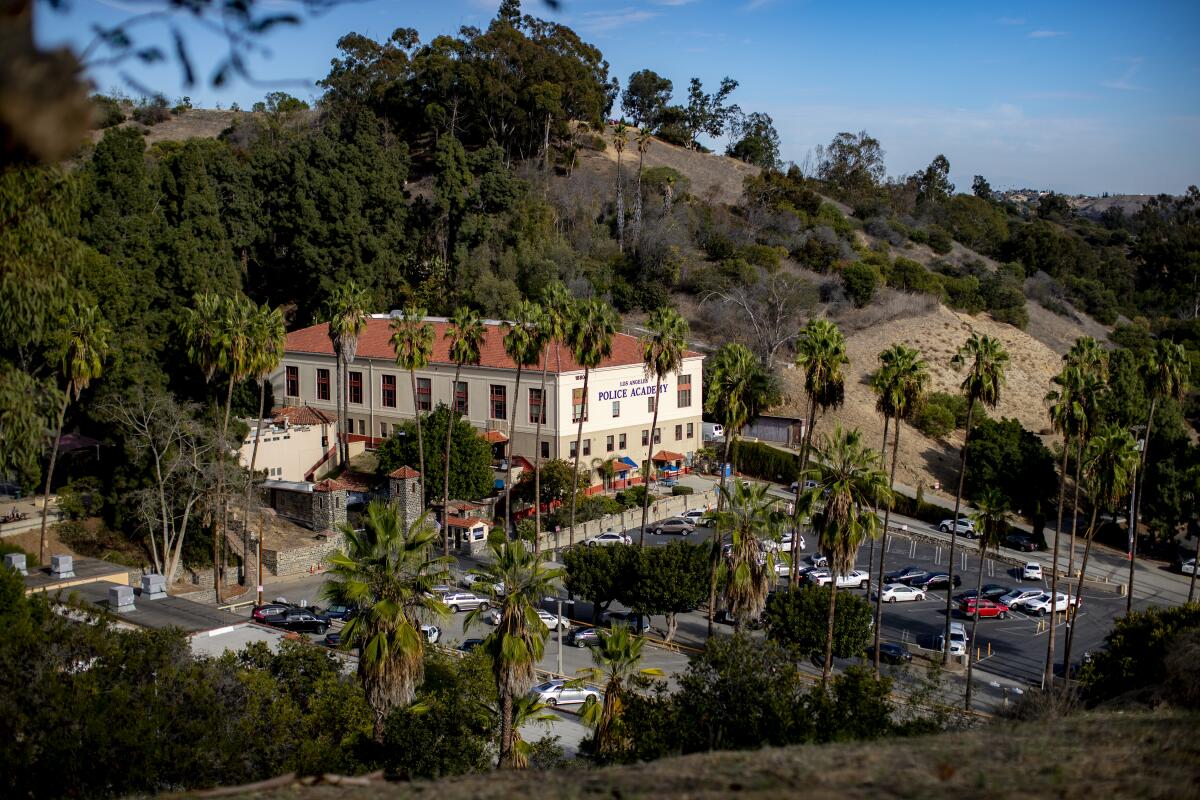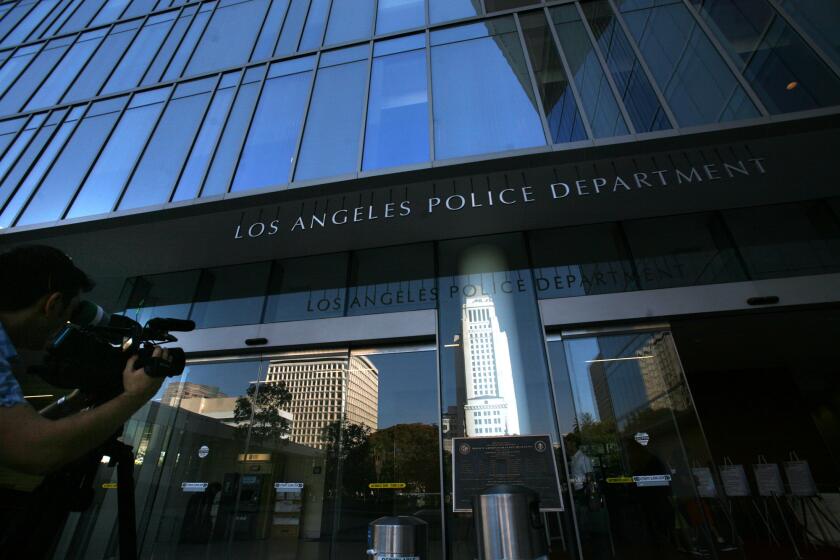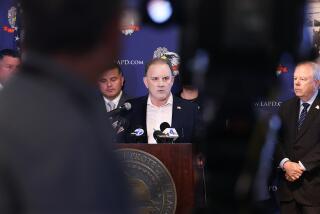How the theft of 44 firearms from an L.A. gun store exploded into an LAPD scandal

Before it all came crashing down, Archi Duenas’ gun-stealing scheme was relatively simple, county prosecutors wrote in a memo. He just couldn’t go on vacation.
Duenas, manager of the gun store at the Los Angeles Police Academy, had been reprimanded over the years for tardiness and sloppy record keeping, but he never took time off, according to the memo. As the store’s closing supervisor, he was there each night to lock up — and hand count the inventory.
If someone else had been assigned that count, they might have discovered that dozens of guns were missing and that Duenas was stealing them and selling them for cash, prosecutors wrote in the memo. But since he was always there, the Los Angeles Police Revolver and Athletic Club was apparently none the wiser.
This went on for years, prosecutors wrote, facilitated by a lack of oversight and safety protocols that are considered standard in other gun stores.
Then, in February 2020, Duenas’ bosses told him he had accrued the “maximum allowable leave hours” and had to take time off, prosecutors wrote in the memo. When he did, another manager finally made the startling discovery: Boxes meant to have guns in them were actually empty.
The resulting investigation quickly led to Duenas’ arrest. But it also uncovered a larger scandal inside the LAPD: The clientele for Duenas’ stolen weapons included cops.
LAPD and L.A. County District Attorney records and interviews by The Times show that what started out as a probe into Duenas has spiraled in the last year and a half, spurring a cascade of allegations of criminal activity, misconduct and corruption on the part of officers and commanders.
There are also dueling claims by some of the accused officers that they have been scapegoated by overzealous investigators despite doing nothing wrong and being victims themselves — not only of Duenas’ deception but also of years of negligence on the part of the LAPD to ensure proper management of the gun store, which it directed officers to use.
That alleged neglect, according to a pending claim against the city from one officer, came despite the fact that the LAPD was aware for years of “prior negligence and mismanagement issues related to the sale, tracking, and documentation of firearms and firearm transactions” by gun store personnel.
The case raises red flags about the LAPD’s oversight of the gun store and its ability to investigate its own officers. It also offers an eye-opening window into the gun culture within the LAPD and the degree to which LAPD officers are allegedly profiting off the sale of firearms — including “off roster” guns that police officers have special access to despite their being declared unsafe for commercial sale in the state.
Investigators alleged LAPD officers, including several who are still on the job, knowingly purchased stolen weapons from Duenas, bought and sold much larger numbers of firearms in questionable ways, and dangerously stored loaded guns in places accessible to children, according to internal police records.
Top commanders, meanwhile, have been accused by the captain who initially oversaw the investigation of purposefully impeding the work of her detectives and assisting those in their crosshairs, including by forcing investigators to interview a high-ranking captain whom they suspected of wrongdoing before they were prepared to do so, and by ushering that same captain into his home — armed and in uniform — while investigators with a warrant were searching it, internal LAPD records show.
“The facts speak for themselves,” wrote Capt. Lillian Carranza, who oversees the LAPD’s commercial crimes division, in an April email to other top officials. “There have been several attempts to shut down this investigation.”
LAPD officials have denied that claim and said the investigation has been handled with the utmost integrity, with detectives following every lead and their work undergoing multiple levels of review.
No officers have been criminally convicted in the case, but one faces a gun charge in Long Beach — which he denies — and several have had criminal cases presented against them to prosecutors. Some of the investigations are ongoing.
This account of the sprawling investigation that began with the gun store thefts is based on dozens of internal LAPD documents reviewed by The Times from sources, including emails between top officials, investigative notes and case summaries, and court records in the case against Duenas. Duenas, who initially faced 25 criminal counts and more than a dozen years in prison, instead received probation in August after pleading no contest to felony grand theft of a firearm and a single misdemeanor count of illegally transferring a firearm.
LAPD Police Academy former gun store manager charged with stealing more than 20 guns
It is also based on interviews, including with attorneys for the accused officers and police officials who requested anonymity to speak candidly about the case, as well as records obtained from Los Angeles County Dist. Atty. George Gascón’s office.
According to the records, detectives in Carranza’s unit who were assigned to dig into the gun thefts traced some of the missing firearms to a group of LAPD officers who were in regular contact with Duenas and made cash deals to obtain weapons from him, including at substantially discounted prices and without proper paperwork or receipts.
In one email to commanders, Carranza described text messages between two of the involved officers that were obtained by investigators, in which one asked the other about the cost of obtaining a certain handgun and was told the gun normally sold for nearly $4,000, and sometimes $5,000 online.
“How much do you think my price will be?” LAPD Capt. Steve Embrich, the interested buyer, allegedly responded.
“For you 3200 cash out the door,” then-LAPD Det. Victor Brown allegedly replied, according to Carranza’s email.
Both Embrich and Brown were among the five law enforcement officers — four from the LAPD and one from the Los Angeles County Sheriff’s Department — who were later found in possession of some of the stolen weapons, internal LAPD records show.
To date, investigators have recovered 34 of 44 firearms they now say were stolen, with the whereabouts of the remaining 10 unknown. Several of the recovered weapons came from the five law enforcement buyers after they were confronted about the thefts or had their homes searched.
Criminal cases alleging all five officers had knowingly purchased stolen firearms from Duenas were presented by LAPD investigators to prosecutors in Gascón’s office, officials confirmed. Investigators also presented evidence to prosecutors that two of the officers had loaded firearms accessible to children in their homes, according to the prosecutors’ memo, which was prepared in response to multiple cases presented by the LAPD in the matter.
Last month, prosecutors in that memo cited insufficient evidence to file charges for knowingly purchasing firearms against three of the officers: Capt. Jonathan Tom, who was found with one of the stolen guns; Sgt. Gus Murra, who was found with five of the stolen guns; and Brown, who was found with three of the stolen guns.
Cases against the two others — Embrich and Los Angeles County Sheriff’s Deputy Christian Maciel — are still pending, the D.A.’s office said.
Tom, commander of the LAPD’s West L.A. station, also was charged by local prosecutors in Long Beach this month with criminal storage of a firearm after investigators serving a search warrant at his home allegedly found an unlocked, fully loaded handgun in a closet, which they said was accessible to Tom’s young son.
Tom has denied any wrongdoing on his part, including in statements that one of his attorneys provided to The Times and in a notice of claim for damages — often a precursor to a lawsuit — that he has filed against the city.
Tom’s attorney, Alexander Tsao, said the gun in question in the Long Beach case was “in the control and custody” of Tom’s wife at the time it was discovered and that his son never had “access to, or even visual reference of, the weapon itself.”
In his claim with the city, Tom called the accusation that he would conspire with Duenas to steal a firearm “patently ridiculous,” said he had filled out all the proper paperwork to register the weapon in his name, and said the only crime associated with his purchase of the firearm was what he alleged was Duenas’ embezzlement of the money he paid for it.
The office of Alex Kessel, Duenas’ attorney, said Duenas has resolved his case and does not wish to comment.
In L.A., the city attorney’s office is considering a similar unsafe gun storage charge against Murra after a search of his home allegedly revealed a loaded 9 millimeter handgun unlocked in a bedroom, accessible to Murra’s young daughter. The city attorney’s office said the case is under review.
Still more allegations remain under review internally within the LAPD as part of internal affairs complaints stemming from the gun investigation, according to multiple LAPD officials.
One officer, Sgt. Marlon Marrache, is accused of tipping off Murra that his police locker was about to be searched, while another, Capt. Brian Morrison, is accused of issuing a veiled threat to investigators working on the gun case that they were “pissing off the gun community,” according to one of Carranza’s emails.
“This comment was received as a threat and an attempt to intimidate investigators,” Carranza wrote in an email to fellow commanders.
The officers either could not be reached for comment or did not respond to requests for comment, though police officials said all were aware of The Times’ interest in speaking with them.
Duenas also could not be reached for comment. Gascón’s office declined to comment on how his case was adjudicated.
Muna Busailah, an attorney representing Tom, Embrich and Morrison, said they had all been ordered by the department not to discuss the case because of pending criminal and administrative investigations.
She said none of them committed a crime, that they deny all allegations against them and that they “anxiously look forward to the day they can speak about this investigation.”
Prosecutors in Gascón’s office noted varying reasons for declining to prosecute Tom, Brown and Murra on the allegations that they’d knowingly purchased stolen guns.
In Tom’s case, they noted the one stolen firearm in his possession had been registered to his name, which they said “negates any intent to steal” on his part. They said he appeared to have purchased the gun from Duenas in cash at below market cost but had a receipt and invoice for the transaction and had cooperated with investigators.
In Brown’s case, prosecutors said they couldn’t prove the case “beyond a reasonable doubt.”
Brown, who has since retired but had been a supervisor in the LAPD’s gun unit, had received three stolen weapons from Duenas, but prosecutors said the case against him was undermined in part because statements he made to investigators before he knew he was a suspect in the case — which were presented as part of the evidence against him — would be inadmissible in court.
Another portion of their reasoning for not bringing charges against Brown was redacted in the memo outlining the decision before it was provided to The Times under a public record request.
In Murra’s case, prosecutors said that he surrendered three stolen weapons to investigators and that two more he had not disclosed were found in his home after a search warrant was served there. Only one of the guns was registered to him. He didn’t have receipts for any of the weapons.
Murra appeared to have a “congenial relationship” with Duenas and invoked the 5th Amendment not to talk to investigators about the guns when they attempted to interview him about them.
Still, the “issue is whether Murra knew or should have known the guns were stolen,” prosecutors said, and they determined they didn’t have a case.
“In sum, the reasonable inference to be drawn from a totality of the evidence in this case is that the officers thought they were purchasing legal firearms at a cash discount, and not acquiring stolen guns,” prosecutors wrote.
As of this week, Tom, Embrich, Marrache, Morrison and Murra were all active members of the LAPD. Brown retired in February. The sheriff’s department said Maciel is currently assigned to the Century station but otherwise declined to comment, citing the D.A.’s open investigation. Maciel could not be reached for comment.
Whether there are additional investigations still ongoing, including at the federal level, is unclear. Lingering are many unresolved questions about the officers’ firearms transactions beyond those with Duenas.
According to the internal LAPD records, Carranza and her team noticed that some of the officers in regular contact with Duenas were not only buying guns from him but appeared to be selling and consigning firearms in relatively large numbers themselves, too.
The investigators questioned whether the officers were selling more guns than they should be under state and federal laws, particularly as some of the guns they’d sold were “off-roster.”
In California, older firearms without certain safety features are excluded from an approved “roster” of guns that can be commercially sold in the state. However, the law allows for law enforcement officers to still purchase those weapons — which, because their sale is restricted, are worth a lot of money.
Five years ago, the federal Bureau of Alcohol, Tobacco, Firearms and Explosives, or ATF, sent a notice to law enforcement agencies across Southern California, including the LAPD, warning them that officers in the region appeared to be engaged in such sales and could be breaking the law. More recently, officers from other agencies have been criminally charged for engaging in such sales without the necessary federal licenses to do so.
As Carranza’s detectives dug deeper, their suspicions about the officers in Duenas’ orbit grew, with Carranza calling the numbers of guns the officers were dealing in “abnormal” in an email to other officials.
Detectives had determined that Embrich had owned 355 different firearms, had sold 36 guns in the last four years — including 17 in 2020 and 10 in 2019 — and had 37 on consignment, Carranza wrote in an April email. A number of the guns were “off-roster” weapons, she wrote.
Detectives had determined Tom had owned 108 firearms, had sold six in the past four years and had 14 on consignment, Carranza wrote. When they searched Tom’s home, they found 11 rifles and seven shotguns with no record of a registered owner, and two guns that were registered to someone other than Tom, she said.
They’d found Brown had owned 145 firearms, and sold 24 in the past four years, and that Murra had owned 49 and sold 20 in the past four years, including 11 in 2020, with two on consignment, Carranza wrote. She said Maciel had owned 53 guns and sold 38 in the last four years, including 17 in 2019.
Carranza wrote that the ATF had been provided with ledgers of the gun sales in question, and would be reviewing them to “make the determination of any federal violations.”
The status of that investigation is unknown; the ATF declined to comment.
In his notice of claim to the city, Tom said the unregistered weapons seized during the raid on his home were family heirlooms that he had received from his father prior to when California law began requiring such long guns to be registered — and “thus were not required to be so registered at the present time.”
“His ownership of those rifles and shotguns pre-date any of those registration requirements, which by the way, were not grandfathered to apply to older transactions,” said Tsao, his attorney.
Tom also denounced the LAPD’s investigation of him as misguided and extreme at nearly every stage — alleging he was “swept up in an ongoing and overly explorative investigation that has minimal connection with him.”
Despite his nearly 25 years with the LAPD and his wife’s clean criminal record, Carranza’s unit decided to surround his home — and those of his neighbors — with a team of officers in tactical gear while they knew Tom was at work in “an outrageous show of force and public demonstration of aggression,” Tom alleged.
He also alleged that investigators improperly shared information about their investigation publicly, including with The Times, and that the investigation tarnished his reputation and resulted in his being skipped over for a promotion to commander.
“The direct actions taken by [Los Angeles Police Revolver and Athletic Club], LAPD officials, and other City of Los Angeles representatives after the embezzlement of funds by Duenas were overtly public and negligently planned, thereby subjecting Claimant to maximum humiliation, judgment, and isolation from his neighbors, his civilian staff and subordinate officers, his LAPD peers, his operational superiors and the general public,” his claim states.
It says Tom seeks to recover no less than $5 million in damages. The LAPD declined to comment on Tom’s claims. The city attorney’s office said it was reviewing them.
Leaders of the Los Angeles Police Revolver and Athletic Club did not respond to requests for comment, but according to prosecutors, the future of the store was uncertain.
In files reviewed by The Times, prosecutors noted that the store had previously been cited by the Department of Justice “for errors in their documentation of firearms” and said it was unknown whether the store’s federal firearm license was “in jeopardy” or if the store would be investigated in relation to Duenas’ misconduct and other errors in record-keeping.
“LAPRAAC does not wish to comment on your story at this time,” attorney Michael Kanne said.
Whether other overseers of the LAPD will conduct reviews of their own is also unclear.
In a statement, the LAPD inspector general’s office said it “has received information from multiple sources regarding this investigation” and was “continuing to monitor the Department’s response to all associated allegations of misconduct to ensure they are handled thoroughly and appropriately.”
The office has interceded in previous cases involving LAPD officers profiting off the sale of firearms.
In one example from 2013, the FBI investigated whether members of the SWAT unit had violated the law by purchasing large numbers of custom-made handguns and reselling them for profit. The then-LAPD inspector general found sales records indicating that as many as 324 pistols had been purchased by the unit, which only had about 60 officers assigned to it.
In another case from 2014, officers in the Firearms and Tactics Section who had evaluated Smith & Wesson handguns for a new department contract used their relationship with the gun company to privately purchase discounted pistols for members of the unit, a possible violation of city ethics rules, according to a report by the inspector general.
Throughout the current investigation, Carranza regularly briefed high-ranking officials on her team’s work, in part because she believed the investigation was being stymied internally by her direct bosses, internal LAPD records show.
Among other claims, Carranza said that Deputy Chief Kris Pitcher forced her investigators to interview Tom before they were ready to do so and that since-retired Deputy Chief Vito Palazzolo had inappropriately escorted Tom into his home in full uniform, and with his service weapon on him, as officers were serving a search warrant there.
Carranza, who is also involved in a sexual harassment lawsuit against the city, said she had been ordered not to discuss the gun case.
Police officials have denied Carranza’s claims of impropriety by commanders.
Pitcher, who oversees the LAPD’s detective bureau, including Carranza’s unit, declined to address Carranza’s specific claims about him — saying he didn’t know if any internal complaints were pending — but said the investigation was “absolutely thorough” and the integrity of the work “outstanding.”
Because the case involved allegations against officers, Pitcher said, it was subjected to even more scrutiny than normal — with the facts of the case “reviewed and re-reviewed” many times in discussions that included police personnel but also personnel from Gascón’s office.
More to Read
Sign up for Essential California
The most important California stories and recommendations in your inbox every morning.
You may occasionally receive promotional content from the Los Angeles Times.













